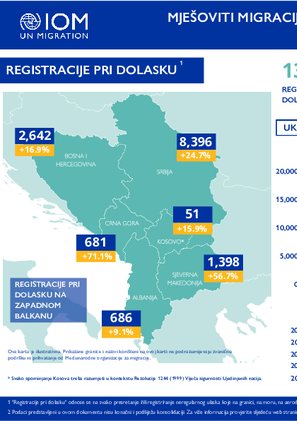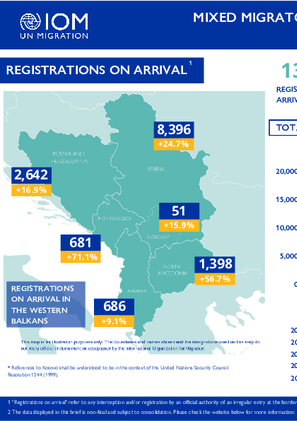-
Countries
-
Data and Analysis
-
Special Focus
-
Crisis Responses
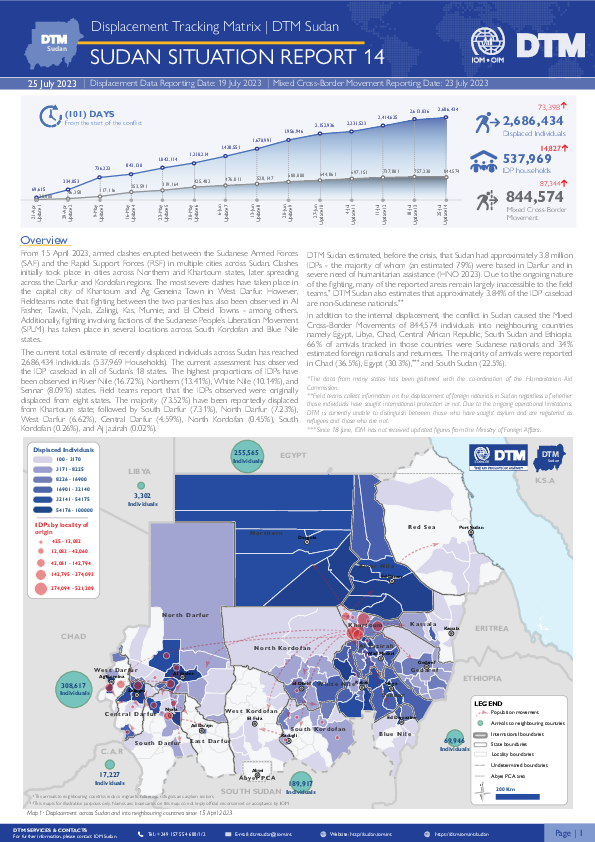
Contact
DTM Sudan; dtmsudan@iom.int
Language
English
Location
Sudan
Period Covered
Jul 25 2023
Jul 19 2023
Activity
- Mobility Tracking
- Baseline Assessment
From 15 April 2023, armed clashes erupted between the Sudanese Armed Forces (SAF) and the Rapid Support Forces (RSF) in multiple cities across Sudan, including Khartoum, Al Fasher, Kebkabiya, Merowe, Nyala, Zalingi, Ag Geneina, and El Obeid. DTM Sudan has been receiving reports of widespread displacement across different states in Sudan due to the ongoing security situation.
- DTM Sudan estimates that, since 15 April 2023, approximately 2,686,434 individuals (537,969 households) have been displaced internally as a result of the conflict. Notably, the current estimate for displacement in the previous 101 days is greater than that of recorded displacement during the previous four years.
- Furthermore, an estimated additional 844,574 individuals have crossed into neighbouring countries.
Due to the ongoing nature of the fighting, many areas reportedly remain inaccessible to field teams. DTM estimates of displacement are based on preliminary reports from field teams and should be taken as estimations only.
The IDP caseload has sought shelter in locations across all of Sudan’s 18 states. IDPs have been originally displaced from eight states, including Khartoum, West Darfur, South Darfur, North Darfur, Central Darfur, North Kordofan, South Kordofan, and Aj Jazirah.
Disclaimer: DTM Sudan notes that military clashes remain continuous in many areas across Sudan in particular in Khartoum and the Darfur region – limiting humanitarian access. Additionally, field teams have reported severe telecommunication and connectivity issues, as well as escalating economic pressures which have impacted the capacity for domestic travel. As such, DTM is currently conducting remote interviews with key informants across its network and is currently unable to engage in the additional verification of these figures. Data on flows into neighbouring countries is based on available information from DTM flow monitoring networks and secondary sources.
Mjesečni pregled:
- Dolasci na Zapadni Balkan
- Top tri nacionalnosti pri dolasku u izvještajnom mjesecu (or if you have space: Tri najzastupljenije nacionalnosti u izvještajnom mjesecu)
- Prisustvo migranata u prihvatnim centrima
- Prisustvo migranata van prihvatnih centara
- Povratak i reintegracija
Monthly Overview of:
- Arrivals in the Western Balkans
- Top three nationalities at arrivals in the reporting month
- Migrants presence in reception facilities
- Migrants presence outside reception facilities
- Returns and reintegration
Contact
DTM Yemen, iomyemendtm@iom.int
Location
Yemen
Activity
- Mobility Tracking
- Event Tracking
Period Covered
Jul 16 2023 -Jul 22 2023
From 1 January to 22 July 2023, IOM Yemen DTM tracked 3,805 households (HH) (22,830 Individuals) who experienced displacement at least once.
Between 16 and 22 July 2023, IOM Yemen DTM tracked 61 households (366 individuals) displaced at least once. The majority of people moved into/within the following governorates and districts:
- Lahj (31 HHs) – Al Qubaytah (31 HHs) district. All displacements in the governorate originated from Ta’iz.
- Ma’rib (14 HHs) – Ma’rib City (7 HHs), Harib (7 HHs) districts. Most displacements in the governorate originated from Ma’rib and Al Hodeidah.
- Al Hodeidah (7 HHs) – Hays (5 HHs), Al Khukhah (2 HHs) districts. Most displacements in the governorate originated from Al Hodeidah and Ta’iz.
- Ta’iz (38 HHs) – Mawiyah (20 HHs), Dimnat Khadir (11 HHs), Maqbanah (6 HHs) districts.
- Al Hodeidah (7 HHs) – Al Hali (3 HHs), Bayt Al Faqih (1 HHs), Al Jarrahi (1 HHs) districts.
- Ma’rib (7 HHs) – Harib (7 HHs) district.
Population Groups
Survey Methodology
Unit of Analysis Or Observation
Type of Survey or Assessment
Keywords
Geographical Scope
Administrative boundaries with available data
The current dataset covers the following administrative boundaries
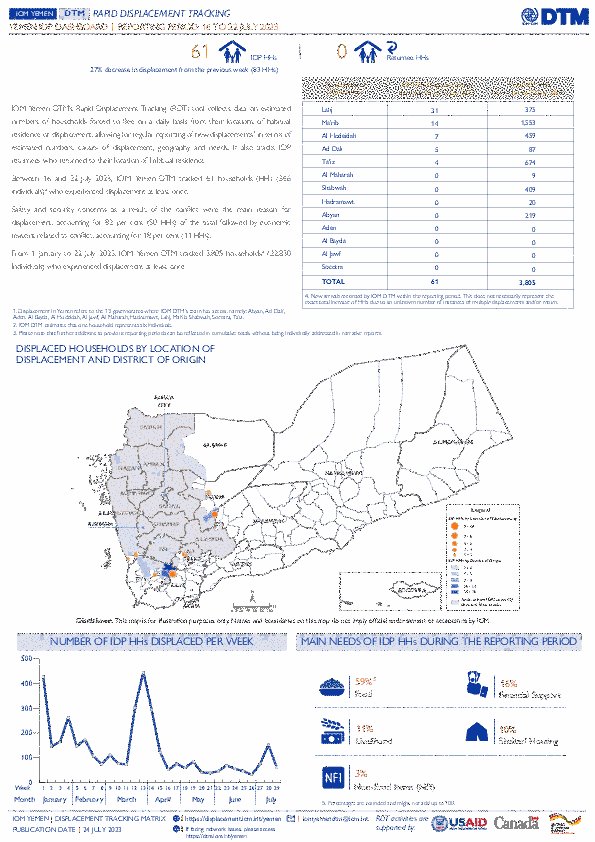
Contact
DTM Yemen, iomyemendtm@iom.int
Language
English
Location
Yemen
Period Covered
Jul 16 2023
Jul 22 2023
Activity
- Rapid Emergency Registration
- Mobility Tracking
IOM Yemen DTM’s Rapid Displacement Tracking (RDT) tool collects data on estimated numbers of households forced to flee on a daily basis from their locations of origin or displacement, allowing for regular reporting of new displacements in terms of estimated numbers, geography, and needs. It also tracks returnees who returned to their location of origin.
From 1 January to 22 July 2023, IOM Yemen DTM tracked 3,805 households (HH) (22,830 Individuals) who experienced displacement at least once.
Between 16 and 22 July 2023, IOM Yemen DTM tracked 61 households (366 individuals) displaced at least once. The majority of people moved into/within the following governorates and districts:
- Lahj (31 HHs) – Al Qubaytah (31 HHs) district. All displacements in the governorate originated from Ta’iz.
- Ma’rib (14 HHs) – Ma’rib City (7 HHs), Harib (7 HHs) districts. Most displacements in the governorate originated from Ma’rib and Al Hodeidah.
- Al Hodeidah (7 HHs) – Hays (5 HHs), Al Khukhah (2 HHs) districts. Most displacements in the governorate originated from Al Hodeidah and Ta’iz.
The majority of people moved from the following governorates and districts:
- Ta’iz (38 HHs) – Mawiyah (20 HHs), Dimnat Khadir (11 HHs), Maqbanah (6 HHs) districts.
- Al Hodeidah (7 HHs) – Al Hali (3 HHs), Bayt Al Faqih (1 HH), Al Jarrahi (1 HH) districts.
- Ma’rib (7 HHs) – Harib (7 HHs) district.
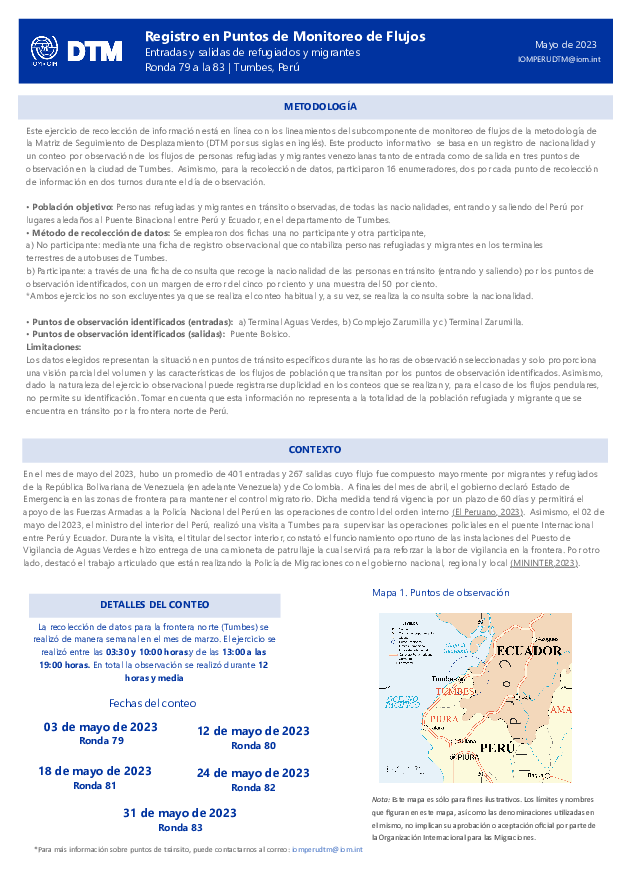
Contact
DTM Peru, IOMDTMPeru@iom.int
Language
English
Location
Peru
Period Covered
May 03 2023
May 31 2023
Activity
- Flow Monitoring
En el mes de mayo del 2023, hubo un promedio de 401 entradas y 267 salidas cuyo flujo fue compuesto mayormente por migrantes y refugiados de la República Bolivariana de Venezuela (en adelante Venezuela) y de Colombia. A finales del mes de abril, el gobierno declaró Estado de Emergencia en las zonas de frontera para mantener el control migratorio. Dicha medida tendrá vigencia por un plazo de 60 días y permitirá el apoyo de las Fuerzas Armadas a la Policía Nacional del Perú en las operaciones de control del orden interno (El Peruano, 2023). Asimismo, el 02 de mayo del 2023, el ministro del interior del Perú, realizó una visita a Tumbes para supervisar las operaciones policiales en el puente Internacional entre Perú y Ecuador. Durante la visita, el titular del sector interior, constató el funcionamiento oportuno de las instalaciones del Puesto de Vigilancia de Aguas Verdes e hizo entrega de una camioneta de patrullaje la cual servirá para reforzar la labor de vigilancia en la frontera. Por otro lado, destacó el trabajo articulado que están realizando la Policía de Migraciones con el gobierno nacional, regional y local (MININTER,2023).
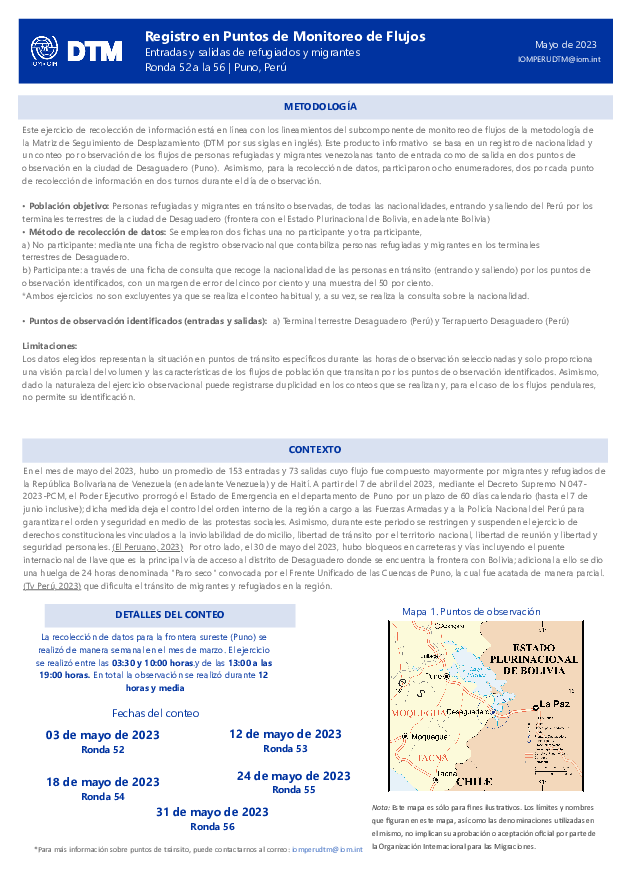
Contact
DTM Peru, IOMDTMPeru@iom.int
Language
English
Location
Peru
Period Covered
May 03 2023
May 31 2023
Activity
- Flow Monitoring
En el mes de mayo del 2023, hubo un promedio de 153 entradas y 73 salidas cuyo flujo fue compuesto mayormente por migrantes y refugiados de la República Bolivariana de Venezuela (en adelante Venezuela) y de Haití. A partir del 7 de abril del 2023, mediante el Decreto Supremo N 047-2023-PCM, el Poder Ejecutivo prorrogó el Estado de Emergencia en el departamento de Puno por un plazo de 60 días calendario (hasta el 7 de junio inclusive); dicha medida deja el control del orden interno de la región a cargo a las Fuerzas Armadas y a la Policía Nacional del Perú para garantizar el orden y seguridad en medio de las protestas sociales. Asimismo, durante este periodo se restringen y suspenden el ejercicio de derechos constitucionales vinculados a la inviolabilidad de domicilio, libertad de tránsito por el territorio nacional, libertad de reunión y libertad y seguridad personales. (El Peruano, 2023) Por otro lado, el 30 de mayo del 2023, hubo bloqueos en carreteras y vías incluyendo el puente internacional de Ilave que es la principal vía de acceso al distrito de Desaguadero donde se encuentra la frontera con Bolivia; adicional a ello se dio una huelga de 24 horas denominada "Paro seco" convocada por el Frente Unificado de las Cuencas de Puno, la cual fue acatada de manera parcial (Tv Perú, 2023) que dificulta el tránsito de migrantes y refugiados en la región.
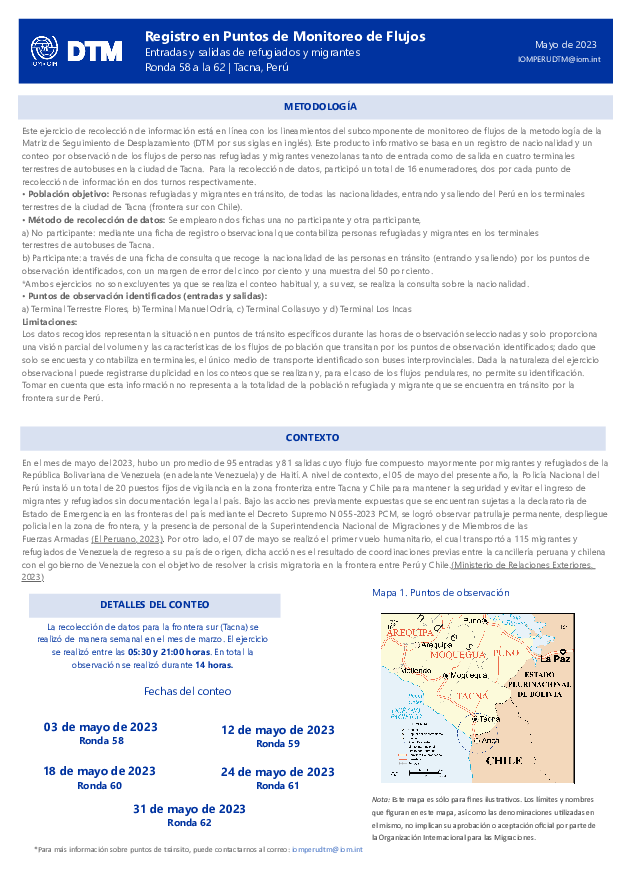
Contact
DTM Peru, IOMDTMPeru@iom.int
Language
English
Location
Peru
Period Covered
May 03 2023
May 31 2023
Activity
- Flow Monitoring
En el mes de mayo del 2023, hubo un promedio de 95 entradas y 81 salidas cuyo flujo fue compuesto mayormente por migrantes y refugiados de la República Bolivariana de Venezuela (en adelante Venezuela) y de Haití. A nivel de contexto, el 05 de mayo del presente año, la Policía Nacional del Perú instaló un total de 20 puestos fijos de vigilancia en la zona fronteriza entre Tacna y Chile para mantener la seguridad y evitar el ingreso de migrantes y refugiados sin documentación legal al país. Bajo las acciones previamente expuestas que se encuentran sujetas a la declaratoria de Estado de Emergencia en las fronteras del país mediante el Decreto Supremo N 055-2023 PCM, se logró observar patrullaje permanente, despliegue policial en la zona de frontera, y la presencia de personal de la Superintendencia Nacional de Migraciones y de Miembros de las Fuerzas Armadas (El Peruano, 2023). Por otro lado, el 07 de mayo se realizó el primer vuelo humanitario, el cual transportó a 115 migrantes y refugiados de Venezuela de regreso a su país de origen, dicha acción es el resultado de coordinaciones previas entre la cancillería peruana y chilena con el gobierno de Venezuela con el objetivo de resolver la crisis migratoria en la frontera entre Perú y Chile (Ministerio de Relaciones Exteriores, 2023)

Contact
DTMUkraine@iom.int
Language
English
Location
Ukraine
Period Covered
Jun 01 2023
Jun 30 2023
Activity
- Return Intention
- Mobility Tracking
This factsheet provides an overview of data from Round 3 of the Conditions of Return Assessment (CoRA), which was conducted in May and June 2023 in 51 hromadas across 14 oblasts. For access to the full report and operational dataset - which provide location and hromada-level population estimates and conditions data, please email DTMUkraine@iom.int.
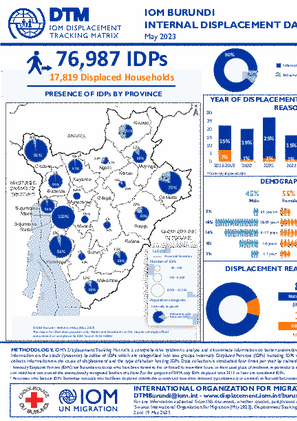
Contact
DTM Burundi, DTMBurundi@iom.int
Language
English
Location
Burundi
Period Covered
May 02 2023
May 19 2023
Activity
- Mobility Tracking
- Baseline Assessment
IOM’s Displacement Tracking Matrix is a comprehensive system to analyse and disseminate information to better understand the movements and needs of Internally Displaced Persons (IDPs) in Burundi. The baseline assessment aims at providing information on the stock (presence) by colline of IDPs which are categorized into two groups: Internally Displaced Persons (IDPs) including IDPs who returned to their colline of origin but not their home and returnees who became IDPs. The baseline assessment also collects information on the cause of displacement and the type of shelter hosting IDPs. Data collection is conducted four times per year by trained Burundian Red Cross volunteers operating at all administrative levels: provinces, communes and collines.
